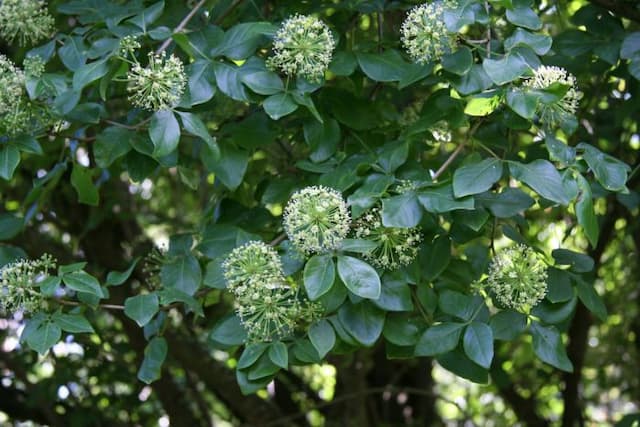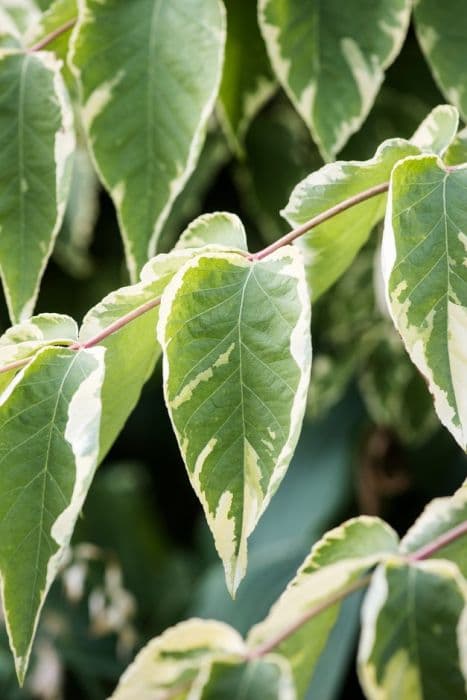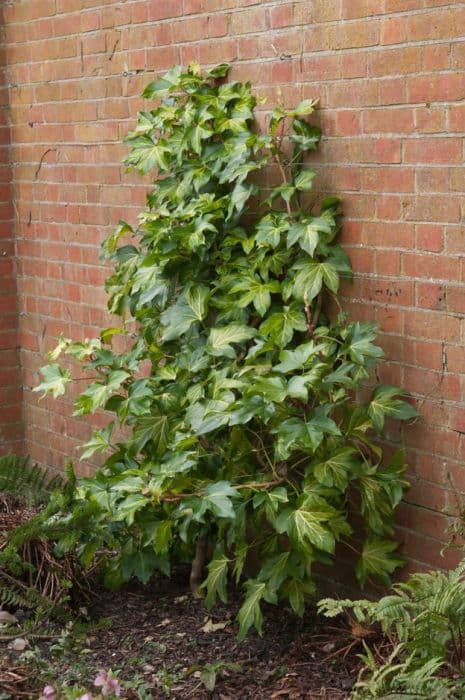Goldchild Ivy Hedera helix 'Goldchild' (v)

ABOUT
The Goldchild Ivy is a visually striking variety of ivy that is widely appreciated for its ornamental appeal. This plant features vibrant leaves that are a blend of deep green and bright gold. Each leaf is uniquely patterned with these two colors, where the green largely occupies the central part of the leaf, and the golden yellow to creamy hues often elegantly edge the variegated foliage. The leaves themselves are typically shaped with three to five pointed lobes, creating a star-like silhouette that adds to the plant's charm. When the leaves are young, they may exhibit a more vivid coloration and as they mature, the hues can deepen, providing a rich tapestry of shades on a single plant. The overall impression is one of a lush, colorful foliage that can breathe life into any space, making the Goldchild Ivy a popular choice for both indoor and outdoor settings.
About this plant
 Names
NamesFamily
Araliaceae.
Synonyms
English Ivy, Common Ivy, European Ivy, Ivy.
Common names
Hedera helix 'Goldchild'
 Toxicity
ToxicityTo humans
English Ivy, which includes the variety Hedera helix 'Goldchild', contains compounds that can be toxic to humans if ingested. The plant can cause irritation to the skin and mucous membranes and, if eaten, may result in symptoms such as abdominal pain, vomiting, and diarrhea. In severe cases, ingestion could lead to more serious symptoms like difficulty in breathing, fever, and delirium. It is important to avoid consuming any part of the English Ivy plant.
To pets
English Ivy, which includes the variety Hedera helix 'Goldchild', is toxic to pets such as cats and dogs. The plant contains saponins which can cause vomiting, diarrhea, abdominal pain, hypersalivation, and in severe cases, difficulty in breathing and muscular incoordination if ingested by pets. It is important to prevent pets from chewing or ingesting any part of the English Ivy plant to avoid these symptoms.
 Characteristics
CharacteristicsLife cycle
Perennials
Foliage type
Evergreen
Color of leaves
Variegated
Height
6-9 feet (1.8-2.7 meters)
Spread
6-10 feet (1.8-3 meters)
Plant type
Climber
Hardiness zones
5
Native area
Europe
Benefits
 General Benefits
General Benefits- Visual Appeal: Its variegated leaves with green centers and golden-yellow edges add color and visual interest to gardens or indoor spaces.
- Low Maintenance: English Ivy 'Goldchild' is known for being easy to care for as it has minimal watering and feeding requirements.
- Versatility: It can be used in a variety of settings such as ground cover, wall climbing, or in hanging baskets for ornamental purposes.
- Drought Tolerance: Once established, it can tolerate periods of drought, making it a suitable plant for various climates and conditions.
- Shade Tolerance: This cultivar thrives in both partial shade and full shade, which makes it a great option for darker areas where other plants might struggle.
- Covers Unsightly Areas: It can rapidly grow over walls or fences to cover unsightly areas, providing a natural green aesthetic.
- Year-Round Interest: English Ivy 'Goldchild' keeps its foliage throughout the year, offering consistent visual appeal even in winter.
- Erosion Control: Its dense growth habit can help prevent soil erosion on slopes and other vulnerable areas.
- Habitat for Wildlife: Provides shelter and food for birds and insects, contributing to local biodiversity.
- Soil Improvement: As it grows, it can help improve soil structure and quality in the garden beds where it is planted.
 Medical Properties
Medical Properties- Expectorant - Common ivy may be used in herbal medicine as an expectorant.
- Anti-inflammatory - The saponins found in ivy are known for their anti-inflammatory properties.
- Antispasmodic - It may also act as an antispasmodic to relieve muscle spasms.
- Antimicrobial - Ivy extracts have shown some antimicrobial effects in studies.
- Topical treatment for certain skin conditions - Some preparations are used to alleviate skin conditions such as eczema, although this use is not mainstream.
 Air-purifying Qualities
Air-purifying QualitiesThis plant is not specifically known for air purifying qualities.
 Other Uses
Other Uses- Topiary Art: English Ivy 'Goldchild' can be trimmed and shaped to create living sculptures in the garden, providing a unique artistic element to landscapes.
- Natural Dye: The leaves of English Ivy can be used to produce a range of natural dyes for fabrics, offering an eco-friendly alternative to synthetic dyes.
- Erosion Control: When planted on slopes or areas prone to erosion, English Ivy’s dense growth can help stabilize soil and prevent soil erosion.
- Backdrop for Photography: The variegated leaves of English Ivy can serve as a stunning, natural backdrop for outdoor photography sessions.
- Craft Material: The vines and leaves can be incorporated into wreaths and other craft projects, providing a natural touch to handmade decorations.
- Trellis Coverage: English Ivy is ideal for growing on trellises to create living screens that enhance privacy and aesthetic appeal in gardens and patios.
- Aquarium Decoration: When properly treated and submerged, English Ivy can be used as a decorative element in aquariums, offering a unique look under water.
- Labyrinth or Maze Design: English Ivy can be trained to grow along the ground patterns, helping to create green, living labyrinths or mazes in large garden spaces.
- Green Roofing: English Ivy is suitable for planting on green roofs, where it can help moderate building temperature and add visual appeal to urban structures.
- Seasonal Decorations: The eye-catching foliage of English Ivy can be used in fall and winter decorations, providing a pop of color during the colder months.
Interesting Facts
 Feng Shui
Feng ShuiThe English ivy is not used in Feng Shui practice.
 Zodiac Sign Compitability
Zodiac Sign CompitabilityThe English ivy is not used in astrology practice.
 Plant Symbolism
Plant Symbolism- Connection and Friendship: English ivy often symbolizes strong connections and friendships due to its climbing nature, which involves attaching itself firmly to surfaces as it grows.
- Eternal Life: The evergreen aspect of English ivy represents eternal life and resilience as the plant remains green throughout the year, even in harsh winters.
- Fidelity and Attachment: The way English ivy clings to walls and trees is often seen as a metaphor for fidelity and attachment, making it a common plant in wedding decor.
- Protection: In some cultures, English ivy is thought to offer protection by warding off evil spirits, which is why it was traditionally planted around homes.
- Prosperity and Growth: The vigorous growth habit of English ivy can indicate a desire for prosperity and personal growth.
- Survival and Determination: This plant's ability to survive in various conditions symbolizes the human qualities of determination and the ability to overcome adversity.
 Water
WaterEnglish Ivy 'Goldchild' should typically be watered when the top inch of soil feels dry to the touch. Ensure a thorough soaking so that water runs out of the drainage holes at the bottom of the pot, indicative of moistened soil throughout the root area. On average, this may be approximately once a week, but frequency will vary depending on environmental conditions like temperature and humidity. It's crucial not to overwater and allow the roots to sit in standing water to prevent root rot. As for the amount, for a standard houseplant in a 10-inch pot, use around 16 to 32 ounces of water each time, adjusting based on the soil's dryness level.
 Light
LightEnglish Ivy 'Goldchild' thrives in a variety of light conditions, but it prefers bright, indirect light. Direct sunlight can scorch the leaves, while too little light can cause the variegation to fade. A north or east-facing window is an ideal spot, providing enough light without the harsh intensity of direct midday sunlight.
 Temperature
TemperatureEnglish Ivy 'Goldchild' fares well in a range of temperatures, ideally between 50 and 70 degrees Fahrenheit. While it can survive temporarily outside this range, growth may be slowed at temperatures below 50 degrees and leaves can suffer damage above 90 degrees. The plant is hardy indoors in typical household temperatures which generally sit within its comfort zone.
 Pruning
PruningPruning English Ivy 'Goldchild' helps maintain its shape and encourage fuller growth. The best time to prune is in the spring or summer, when the plant is actively growing. Cut back any overly long vines to promote branching, and remove any dead or damaged leaves as necessary. Routine pruning can be done a few times a year to keep the plant tidy and healthy.
 Cleaning
CleaningAs needed
 Soil
SoilEnglish Ivy 'Goldchild' thrives in a soil mix consisting of one part peat or coco coir, one part perlite, and two parts potting soil, ensuring well-draining conditions to prevent root rot. The ideal soil pH should be slightly acidic to neutral, ranging from about 6.0 to 7.5.
 Repotting
RepottingEnglish Ivy 'Goldchild' should be repotted every two to three years or when the plant becomes root-bound. It's vital to use a fresh soil mix and a slightly larger pot to give the roots room to grow.
 Humidity & Misting
Humidity & MistingEnglish Ivy 'Goldchild' performs best in moderate to high humidity levels, ideally between 40% to 70%. This range helps to keep the foliage vibrant and healthy, reducing the risk of pest issues related to dry air.
 Suitable locations
Suitable locationsIndoor
Place in indirect light and mist regularly.
Outdoor
Plant in partial shade, shelter from harsh sun.
Hardiness zone
5-11 USDA
 Life cycle
Life cycleEnglish Ivy 'Goldchild' (v) begins its life as a seed, which requires a period of cold temperatures to germinate. Upon sprouting, the plant enters its juvenile phase, characterized by rapid growth and the production of dense, lobed, variegated leaves which cling to surfaces via aerial rootlets. As it matures, the vine transitions to its adult phase, exhibiting broader, unlobed leaves and developing woody stems. In this stage, it becomes capable of flowering, with small, inconspicuous greenish-yellow flowers emerging in the fall. Following pollination, these flowers produce small blue-black berries as fruits, which are then dispersed by birds and other animals, starting the cycle anew. English Ivy 'Goldchild' can live for many years, perpetuating its life cycle as long as conditions remain conducive to its growth.
 Propogation
PropogationPropogation time
Spring to Summer
Propogation: The most popular method for propagating English ivy, specifically the Hedera helix 'Goldchild' variety, is through stem cuttings. This can be done in late spring to early summer when the plant's growth is most vigorous. The process involves taking a stem cutting of about 4-6 inches (10-15 centimeters) with several leaves, cutting just below a node (where a leaf meets the stem). The lower leaves are then removed, and the cut end can be dipped in rooting hormone to encourage root development. The prepared cutting is then placed into a pot of moist soil, ensuring at least one node is buried beneath the surface as this is where new roots will develop. The pot should then be kept in indirect light and maintain a consistently moist environment until roots have established, which typically takes several weeks.









